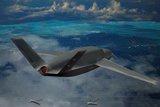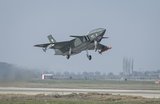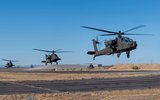US orders integrated helmet spares
Apache pilots use the IHADSS-21 integrated helmet display system. (Photo: Elbit Systems)
US-based Elbit Systems subsidiary EFW is to provide spare parts to support the Integrated Helmet and Display Sight System (IHADSS-21) used by US Army AH-64 Apache helicopter pilots.
Work on the IDIQ sole-source contract, worth up to $75.98 million and awarded by DoD agency Defense Logistics Agency Land and Maritime, is scheduled to be completed in Israel and the US by September 2026.
The IHADSS system supports the AH-64 attack helicopter mission by providing an advanced helmet-mounted display and sighting system that provides heads up display to the pilot and co-pilot.
Shephard Defence Insight notes that HADSS-21 slaves turreted weapons, missile seekers and gimballed night-vision sensors to the pilot’s line of sight.
Related Equipment in Defence Insight
More from Air Warfare
-
![Airbus MQ-72C Lakota Connector progress on track ahead of pending USMC decision]()
Airbus MQ-72C Lakota Connector progress on track ahead of pending USMC decision
The MQ-7C uncrewed aircraft is currently undergoing further internal flight tests ahead of a government test event anticipated for next year.
-
![November Drone Digest: GA-ASI eyes Middle East for Gambit, Edge Group unveils new UAVs]()
November Drone Digest: GA-ASI eyes Middle East for Gambit, Edge Group unveils new UAVs
In November 2025, GA-ASI unveiled a new Gambit variant, the Gambit 6, and appears to be pitching the aircraft series to various customers in the Middle East, which is a fast-emerging CCA market. The Dubai Airshow also saw the unveiling of various Emirati aircraft from Edge Group.
-
![Baykar’s Kizilelma drone makes progress with first air-to-air kill]()
Baykar’s Kizilelma drone makes progress with first air-to-air kill
This test is the latest milestone achieved by the indigenous drone, destroying a target using a beyond-visual-range missile.
-
![Lockheed plans further solid rocket motor investment in Europe and Middle East]()
Lockheed plans further solid rocket motor investment in Europe and Middle East
The company has worked to heavily invest in its solid rocket motor production capabilities, both in the US and internationally, to build a strong supply chain to meet growing demand.
-
![Boeing to build Apache AH-64E attack helicopters for Poland, Egypt and Kuwait]()
Boeing to build Apache AH-64E attack helicopters for Poland, Egypt and Kuwait
The $4.7 billion international order for the three countries will see production conclude around May 2032.






















